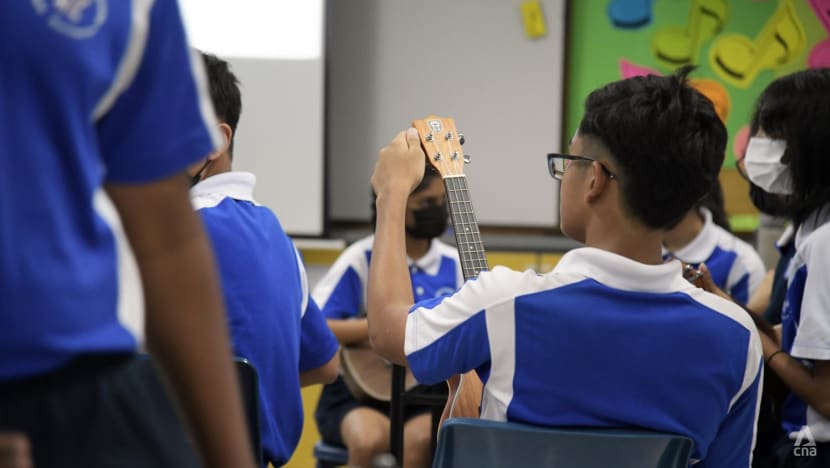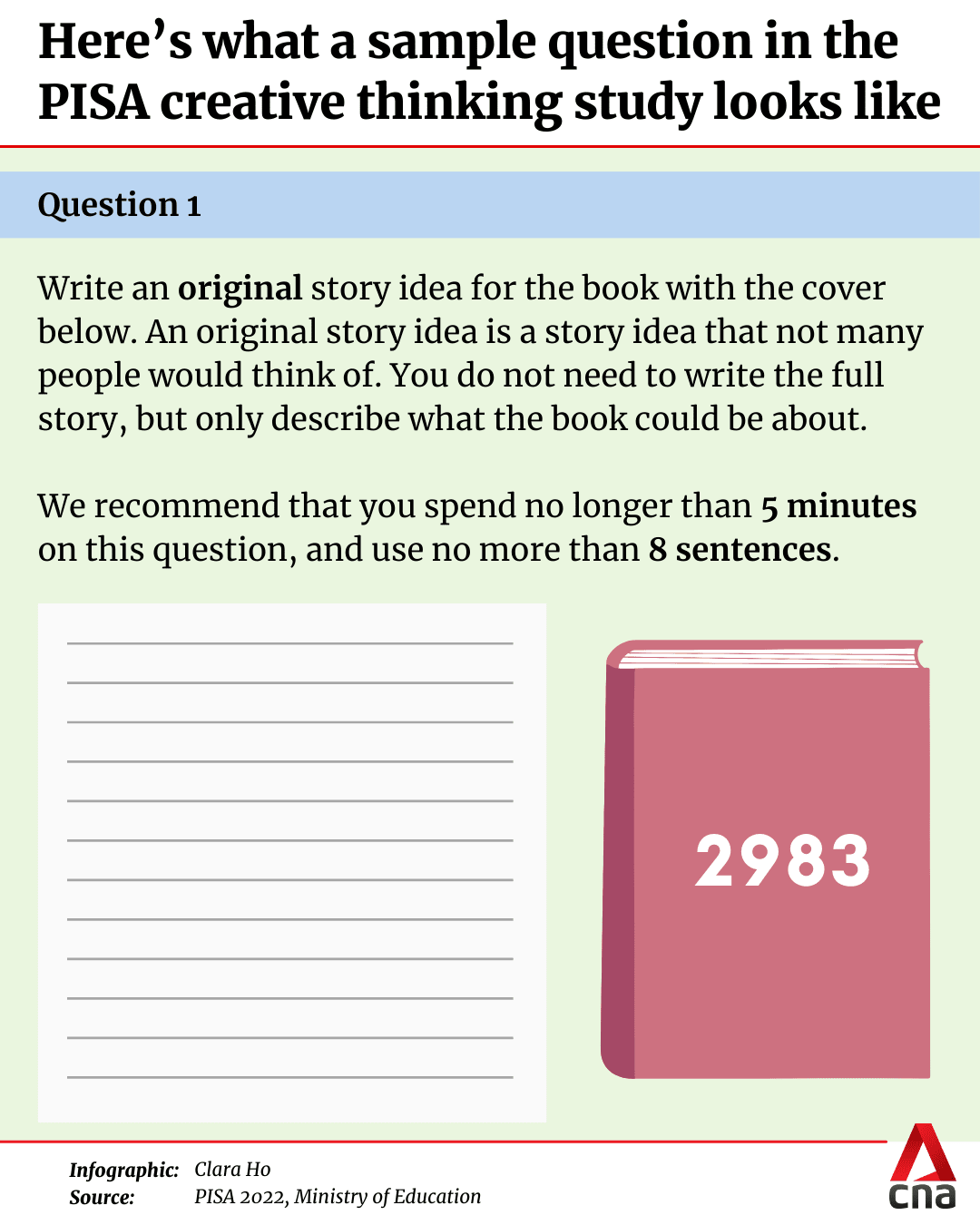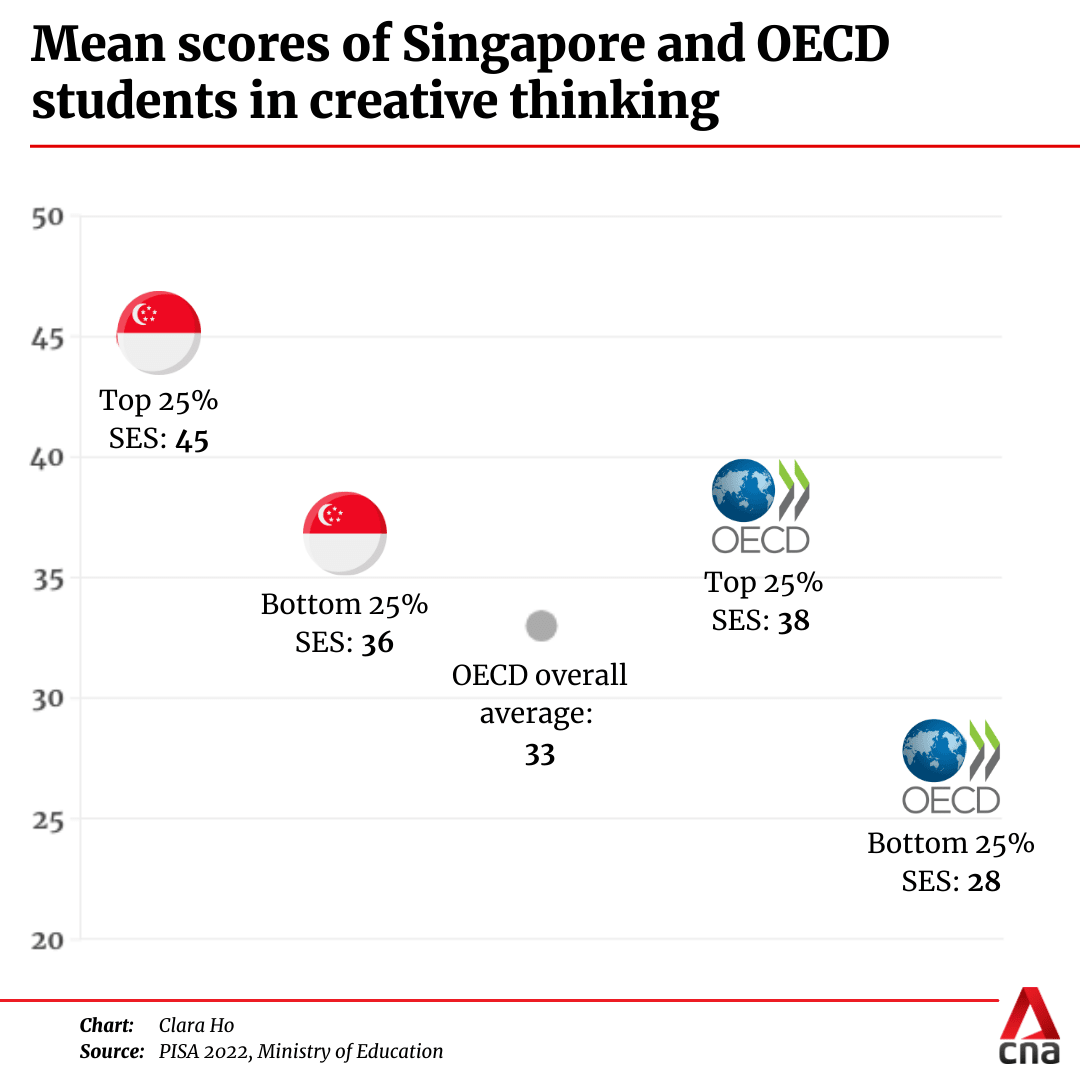Encouraging creativity in the classroom still a challenge despite MOE push, teachers say
Encouraging creativity in the classroom still a challenge despite MOE push, teachers say
Singapore’s 15-year-olds topped the 2022 PISA study on creative thinking, but teachers say it's not easy to encourage creativity in academic work.

Secondary 2 students learning the ukulele during a music lesson at Jurong West Secondary School. (File photo: CNA/Raydza Rahman)
SINGAPORE: When Singapore teens came out tops in a recent worldwide study on creative thinking, it took parents and teachers by surprise.
“I know that MOE (the Ministry of Education) is doing a lot of things to try to promote creativity during the lessons in the classroom,” said Claire, a Chinese language teacher in a primary school.
“But for the syllabus nowadays, we’re still given a very neatly packed problem with a very neatly packed solution. So most of the kids don’t really have the chance to think outside the box.”
In 2022, the Programme for International Student Assessment (PISA) studied creative thinking among students for the first time. The results of the study – where students were tested on their capacity to generate diverse and original ideas – were released last month.
More than half, or 58 per cent, of Singapore students were top performers. This was more than twice the OECD average and the highest among all 64 participating countries and economies.
All five of the teachers CNA spoke to were surprised by the results of the PISA study. Even students themselves did not think they were creative – in the PISA study, just 64 per cent of them said they were confident of being creative, compared with the OECD average of 73 per cent.
While students can generate good, original ideas in some areas of school life, teachers say encouraging creativity in the classroom is still a challenge.
The names of teachers interviewed for this story have been changed at their request as they were not authorised to speak to the media.
INTRODUCING INVENTIVE THINKING
In a post on LinkedIn, Singapore's director-general of education Liew Wei Li confessed to doubting the PISA results at first.
“I thought we might be in the middle of the table, but none of us thought we would be heading the list,” she wrote.
The results show that creative thinking can be taught, Ms Liew added, noting that the Ministry of Education (MOE) started incorporating inventive thinking into its curriculum, teaching and learning guides, and even exam syllabuses where possible 15 years ago.
The national curriculum and school-based programmes are guided by "21st-century competencies", with inventive thinking as a key component, said MOE when the PISA study results were released.
For example, primary school students can express their creativity through the way a story is told or their choice of words in composition writing, the ministry said. Secondary school students have design and technology lessons where they learn how to identify design needs, generate and develop ideas, and then come up with solutions.
Co-curricular activities also provide a platform for students to collaborate and find innovative solutions to problems, it added.
But a National Institute of Education (NIE) associate professor said the PISA study may not be an accurate reading of students' creativity levels.
The tests are a measure of “Little C” creativity, or creativity in our daily lives, not “Big C” creativity, typically associated with major intellectual or technological leaps, said Assoc Prof Heng Tang Tang.
“If we’re talking about ‘Little C’, that is something many of us – including our students – can do decently well at.”
Singapore should “exercise some caution” with the conclusions drawn from the PISA results, because the test format and constructs can shape outcomes, said Assoc Prof Heng.
For example, the tests are conducted on a computer. This could be partly why Singapore students, who tend to be adept at navigating digital devices and online tools, had better results.
CAN'T ALWAYS BE CREATIVE IN EXAMS
Teachers CNA spoke to lauded the scrapping of some exams – such as the mid-year papers for primary and secondary school levels – which has helped students to be more creative with alternate assessment methods like project work.
But on MOE's push to encourage creativity in lessons, teachers said they have to balance this with providing "structure" for students.
For example, when it comes to exam preparation, most teachers focus on ensuring that students' answers match the way exams are marked so that they do well.
“The syllabus requires them to answer certain questions in a certain way … So we also teach the kids that they have to follow step by step, you can’t just write anyhow. That actually restrains them from thinking out of the box,” Claire said.
For example, for Chinese language exams, more creative students might summarise a longer answer and merge multiple points into one sentence. But they may be required to have certain keywords in their answer to get full marks.
“Actually the meaning behind it is about the same. But the problem is that we still will follow the marking scheme. So it’s a bit like you’re forcing them not to be creative.”
A parent of a 15-year-old boy said that for subjects like mathematics, there is usually only one way to solve the question.
“It’s very hard for kids to look at the question and say, let’s find another way of doing this," said Mr Aaron Koh. "You apply this formula, these are the steps, and then you get the answer. There’s no reason for you to even try another way.”
Lily, who teaches English and literature in a secondary school, said she tells her students that there are no right answers, but there are wrong answers.
“I tell them that you can have creativity in your interpretation, but what you need is strong justification for your interpretation,” she said, adding that it is easier to encourage creative expression in literature classes.
But when it comes to essay writing in English, the marking scheme is clearly divided into 10 marks for content and 10 marks for language use, and she tells her students that it is easy to score marks as long as they stay on point.
“My worry with kids is that they’re creative to the point of writing out of point,” she added.
The approach that teachers can take also depends on the profile of the students, said Paulina, who also used to teach English and literature in a secondary school up until recently.
While she had some “geniuses” among her students, she still had to cater to the majority.
“I feel like the strategy to ensure that I can help the majority of the students is really to tell them: ‘This is the exam, this is what you should write in order to cater to the exam.’ So it was very uninspiring teaching.”
Paulina thought at first that student-initiated learning – where children pursue their own interests and learn outside the curriculum – was a good idea.
While this is a ministry initiative, each school conducts this differently.
At Paulina's school, the projects students took on had conditions and outcomes to fulfil. For example, they had to contribute to society in some way.
The requirements made the projects a chore for students and "completely ruined" their motivation, she said.
NIE's Assoc Prof Heng said that newer curriculums aim to give students opportunities to stretch their imagination and connect them to the real world.
But it is difficult to say whether these have shown results, as it is “very much debatable” to what extent standardised tests around "Little C" creativity transfer to "Big C".
“Big C” creativity also needs a wider ecosystem and factors outside of “Little C” parameters to support it, said Assoc Prof Heng.
“Further, Singaporeans’ risk aversion and preference to maintain harmony may stifle their creativity along the “Big C” domain or in other types of creativity, including artistic creativity.”

CREATIVITY OUTSIDE OF LESSONS
Natalie, who teaches Chinese at a secondary school, said that since weighted assessments have replaced mid-year examinations, teachers try to assess students in different ways by giving them a project or problems to solve.
“Our students have impressed us from time to time with the different solutions they come up with or different ways of presenting … Sometimes they do shock us with how creative they can be.”
In character and citizenship education lessons, students discuss many issues, and teachers don’t always define the questions that need to be discussed, Natalie added.
“They can also come up with their own topics that they would like to discuss. I think the key is whether teachers really create those platforms or identify those opportunities,” she said, stressing that students will rise to the occasion if given the chance.
Teachers also need to be creative when planning lessons, said Assoc Prof Heng, adding that she often reminds teachers of this.
“An engaging, coherent and effective lesson role models to students how creativity can be realised in our daily lives. Think about some lessons that stuck in your minds even as adults; chances are some of them feature teachers using creative ways to help us learn.”
Students now also get more opportunities to lead or plan activities for their schoolmates and sometimes the entire school, Natalie said. Other teachers agreed, and said they see the most creative expressions in such non-academic areas.
In one of the classes Lily taught, some students were in charge of planning birthday celebrations throughout the year, and they came up with creative ideas.
For example, each celebration had a theme, and the students would decorate the whiteboard according to the theme, based on what their friends liked.
“Especially for schools that have a strong emphasis on student leadership, I think that it allows these students a lot more room to flourish and to show their creative thinking and creative ideas,” Lily said.

THINKING OUTSIDE THE BOX
Mrs Hui Kai Shan, who has two sons aged 14 and 12, considers her children creative because they are inquisitive and ask many questions. She and her husband also encourage them to find multiple options to deal with issues that they face.
For example, if it is raining heavily in the morning before they go to school, they might discuss alternate ways to get to school without getting wet. They could take a longer route on public transport, bring a change of shoes, or even wrap their shoes in plastic bags.
“Of course, if they choose not to do anything then they will just have to contend with soggy shoes for the entire day … If the parents drive, they can also drop them off, but personally sometimes I don’t offer them the most comfortable option to really encourage them to think of different ways to solve problems,” said the 41-year-old commercial manager.
In the classroom, it’s important not to judge students when they share their ideas and thoughts, said Felicia, who teaches Chinese in a secondary school.
“A lot of students don’t dare to express their views because they are afraid it’s wrong,” she added.
MOE has also pushed them to focus on inquiry-based learning, critical thinking and problem-solving. “It’s not just model answers anymore.”
In Chinese language classes, students also learn about things that are “closer to daily life”, including how to write emails and text for a webpage or brochure. This makes lessons more interesting and relevant to students, she said.
In school, students have a “myopic view”, and only know what their friends and classmates are up to. “They don’t really get to see what other students are doing, or what the world out there is like.”
This is why she jumps at every opportunity to introduce them to other things that are related to her subject, like the arts and theatre, or bring them on learning journeys outside of school for more exposure.
Ms Evelyn Kwek, who has two daughters aged 17 and 18 and a son aged 10, said that while creativity is not one of the main goals of her journey as a parent, it is important to expose them to a wide range of things from a young age.
“That many years of exposing them to different things, I think it definitely helps to build up that muscle to know that they can do many things.”
In their co-curricular activities, her two daughters have had the opportunity to mentor younger students. Community work opens up their worldview and reminds them that there are very different people around them, said Ms Kwek.
“That helps them to build that ability to see things from different perspectives.”
She also finds that her children have been taught to be critical thinkers. In family discussions, they often do not accept things as they are and usually ask deeper questions.
“This is a generation of people who were taught in school … to challenge norms and to push boundaries, and that ambiguity is okay and acceptable.”